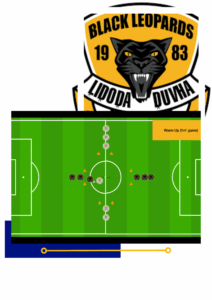
Football with Purpose: Training to Play, Not to Repeat
As we’ve discussed before, this section focuses on football training exercises used with teams I’ve coached, always contextualizing them and reflecting on the reasons and objectives behind them.
👉 If you want to know how these exercises were created and what ideas led me to this approach, click here.
Context
We’re in the 2023/2024 season at Black Leopards FC in South Africa. We were looking for a drill to prepare us for a session in which 1v1 situations would play a central role.
As with other drills we’ve shared previously, this one was placed after the specific warm-up and before the main phase of the session. Its goal was to provide a short stimulus related to the general theme of the day: 1v1 attacking and defending.
One of the characteristics we wanted for this drill was that it be competitive. To achieve that, we designed it so that both the attacker and the defender would face a penalty for not succeeding in their task.
- In attack, the penalty came from losing the ball, if the player lost it, they immediately had to become the defender.
- In defense, the penalty was to perform three extra actions if they failed to recover the ball. If still unsuccessful, a teammate would step in to help and switch roles.

1v1 Competition
The group was divided into two teams. We tried to keep these the same teams that would be used in the next phases of training, to avoid wasting time.
Each team was then split in half and positioned facing each other, with about 15 meters of distance, forming a cross with the opposing team. In front of each of the four lines (two from each team), we placed two cones or poles.
The attacking objective of each team was to carry the ball from one line to the opposite line. Up to the halfway point, players were required to dribble, to force 1v1 scenarios. After that halfway point, a pass was allowed, to keep the drill dynamic and agile.
This pass had to be received between the two cones/poles in front of each line, to force precision.
- If the pass went outside the cones, it was treated as a lost ball, and the player who missed the pass had to switch to defense.
- When the defender successfully recovered the ball, they could immediately pass to a teammate on one of their sides to continue the drill.
Key Considerations
- The distance between lines should be adjusted based on the technical level of the players.
- The gap between cones can be modified to increase or decrease the difficulty.
- Forcing dribbling for the entire drill may reduce its pace.
- Allowing passing throughout the drill changes the objective slightly but can still work—though in that case, the penalty for not recovering the ball should be adjusted.
⚽ Want more competitive training drills designed for real-game behaviors?
📲 Follow us on Instagram @alexdoradoteam for game-based exercises, match prep drills, and practical coaching insights.
📚 Explore more articles and bring competition, context, and clarity into every session you run.
